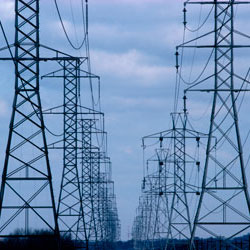 After considering more than 200 sets of public comments, the Federal Energy Regulatory Commission (FERC) has approved Order No. 1000, a final rule to reform its transmission-planning and cost-allocation requirements, with the ultimate goals of facilitating the development of new transmission facilities and lowering the costs of transmission services.
After considering more than 200 sets of public comments, the Federal Energy Regulatory Commission (FERC) has approved Order No. 1000, a final rule to reform its transmission-planning and cost-allocation requirements, with the ultimate goals of facilitating the development of new transmission facilities and lowering the costs of transmission services.
The new rule subjects public utility transmission providers to a host of new requirements involving transmission planning and cost allocation. These improvements, the commission contends, will remove the barriers to the development of new transmission facilities.
Among the new transmission-planning requirements is that transmission providers must develop regional transmission plans and coordinate with neighboring transmission-planning regions. In addition, they will need to take into account the needs established by state and federal laws and regulations.
The new rule also contains a provision designed to avoid delays resulting from issues such as siting and permitting. Transmission providers must develop a contingency plan to implement in the event that these delays affect their ability to maintain reliable service.
In addition, the rule establishes requirements in regard to cost allocation, including the development of regional and interregional cost-allocation methods that meet the commission's specified criteria. Furthermore, participants may contribute to the funding of new transmission facilities, but this may not be used as a regional or interregional cost-allocation method, the ruling states.
Moreover, for transmission facilities selected in a regional transmission plan for the purposes of cost allocation, the federal right of first refusal will be removed from FERC-approved tariffs and agreements, subject to certain limitations. One of these exemptions is for upgrades to existing transmission facilities or on existing rights of way, or for facilities that are not selected in the regional transmission plan for cost-allocation purposes.
The new rule builds upon FERC Order No. 890, which addresses open-access transmission tariff reform. This final rule, which was amended back in 2007, needed to be adapted to reflect the changing needs of the grid, according to FERC Chairman Jon Wellinghoff.
‘We recognized that changes in the electric power industry over the ensuing four-plus years necessitated additional reform to transmission planning and cost allocation to reflect the new demands placed on the nation's transmission system,’ Wellinghoff said in a statement.
One of these industry developments is the increased demand for renewables – such as wind and solar – which necessitates new and upgraded transmission lines.
‘[The North American Electric Reliability Council (NERC)] projects in its 2010 long-term reliability assessment that approximately 60 percent of all new resources expected to be added to the bulk-power system by 2019 will be new wind and solar resources,’ Wellinghoff added. ‘Strengthening and expanding the system for the reliable integration of these resources will require significant investment in transmission.’
According to Wellinghoff, NERC forecasts that there will be a 9% increase in the circuit miles of transmission added, mainly in the West, Southwest, Northeast and Southeast. Of these miles, half will be dedicated to reliability, and more than 27% will address the need to integrate intermittent energy sources such as wind and solar.
The American Wind Energy Association (AWEA) applauded FERC's decision.
‘This is an important step toward removing the main hurdle: how to make sure all users pay their fair share of new lines,’ said AWEA CEO Denise Bode in a statement. ‘Preventing free-riding will help improve grid reliability and reduce electricity bills by facilitating access to lower-cost resources, including wind energy.’
FERC Commissioner Cheryl A. LaFleur said in a statement that an important aspect of the commission order is the adoption of a ‘backstop mechanism to ensure that delays in the development of a regional transmission facility will not prevent incumbents from complying with reliability needs and service obligations.’
‘The final rule requires each transmission provider to amend its open-access transmission tariff to require re-evaluation of the regional transmission plan to determine if delays in the development of a transmission facility require evaluation of alternative solutions, including those proposed by the incumbent, to ensure that incumbents can meet reliability needs and service obligations,’ she explained.
However, Commissioner Philip D. Moeller voiced concern that the new requirements were insufficient.
For instance, ‘This rule cannot address issues like the delays caused by other federal agencies in the siting of important projects, as this commission lacks the legal authority to require other federal agencies to act,’ he said in a statement.
‘And this rule also cannot address issues of state law, regardless of the reliability needs that are served by a new transmission line,’ Moeller continued. ‘Moreover, this rule did not address whether a transmission provider can thwart competitive options by refusing to upgrade its transmission system.’
On the other hand, the rule received support from industry group WIRES, which released a statement praising FERC's decision.
‘The rule removes one of the obstacles to developing the grid that the U.S. needs for the 21st century: narrow cost allocation that does not recognize the way the grid operates and impedes cost recovery for grid investment,’ J. Jolly Hayden, president of WIRES, said in the statement. ‘Under this new rule, no one who does not benefit from new transmission projects will pay for grid expansion.’
Order No. 1000 becomes effective 60 days after publication in the Federal Register. Transmission providers must make compliance filings on most issues within one year of the effective date, FERC notes, and interregional transmission coordination and cost-allocation compliance filings are required within 18 months of the effective date.
In addition, public utility transmission providers must consult with stakeholders in the region in developing and implementing their compliance filings.



